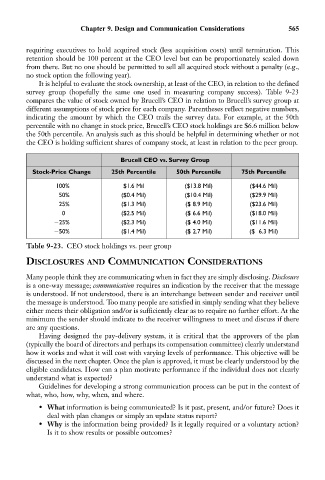Page 579 - Bruce Ellig - The Complete Guide to Executive Compensation (2007)
P. 579
Chapter 9. Design and Communication Considerations 565
requiring executives to hold acquired stock (less acquisition costs) until termination. This
retention should be 100 percent at the CEO level but can be proportionately scaled down
from there. But no one should be permitted to sell all acquired stock without a penalty (e.g.,
no stock option the following year).
It is helpful to evaluate the stock ownership, at least of the CEO, in relation to the defined
survey group (hopefully the same one used in measuring company success). Table 9-23
compares the value of stock owned by Brucell’s CEO in relation to Brucell’s survey group at
different assumptions of stock price for each company. Parentheses reflect negative numbers,
indicating the amount by which the CEO trails the survey data. For example, at the 50th
percentile with no change in stock price, Brucell’s CEO stock holdings are $6.6 million below
the 50th percentile. An analysis such as this should be helpful in determining whether or not
the CEO is holding sufficient shares of company stock, at least in relation to the peer group.
Brucell CEO vs. Survey Group
Stock-Price Change 25th Percentile 50th Percentile 75th Percentile
100% $1.6 Mil ($13.8 Mil) ($44.6 Mil)
50% ($0.4 Mil) ($10.4 Mil) ($29.9 Mil)
25% ($1.3 Mil) ($ 8.9 Mil) ($23.6 Mil)
0 ($2.5 Mil) ($ 6.6 Mil) ($18.0 Mil)
25% ($2.3 Mil) ($ 4.0 Mil) ($11.6 Mil)
50% ($1.4 Mil) ($ 2.7 Mil) ($ 6.3 Mil)
Table 9-23. CEO stock holdings vs. peer group
DISCLOSURES AND COMMUNICATION CONSIDERATIONS
Many people think they are communicating when in fact they are simply disclosing. Disclosure
is a one-way message; communication requires an indication by the receiver that the message
is understood. If not understood, there is an interchange between sender and receiver until
the message is understood. Too many people are satisfied in simply sending what they believe
either meets their obligation and/or is sufficiently clear as to require no further effort. At the
minimum the sender should indicate to the receiver willingness to meet and discuss if there
are any questions.
Having designed the pay-delivery system, it is critical that the approvers of the plan
(typically the board of directors and perhaps its compensation committee) clearly understand
how it works and what it will cost with varying levels of performance. This objective will be
discussed in the next chapter. Once the plan is approved, it must be clearly understood by the
eligible candidates. How can a plan motivate performance if the individual does not clearly
understand what is expected?
Guidelines for developing a strong communication process can be put in the context of
what, who, how, why, when, and where.
• What information is being communicated? Is it past, present, and/or future? Does it
deal with plan changes or simply an update status report?
• Why is the information being provided? Is it legally required or a voluntary action?
Is it to show results or possible outcomes?

